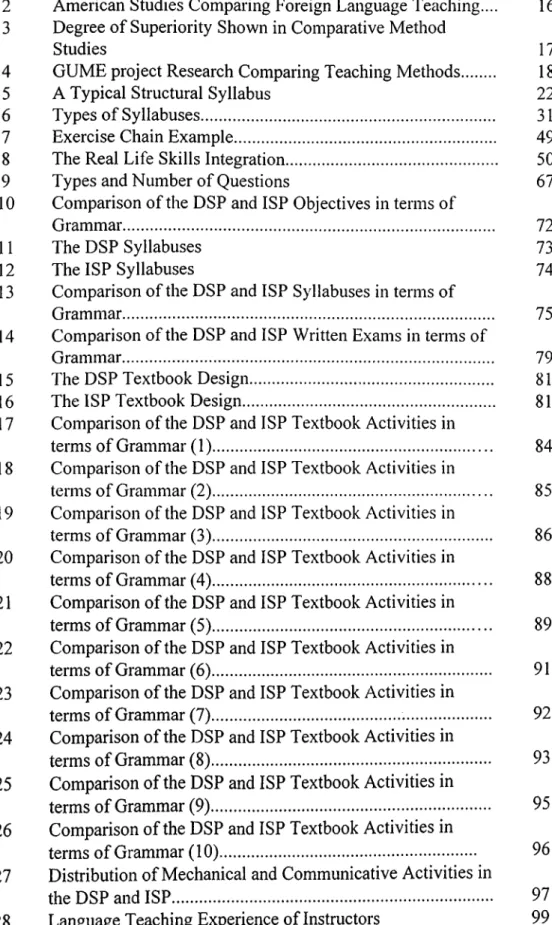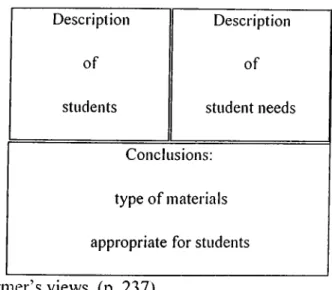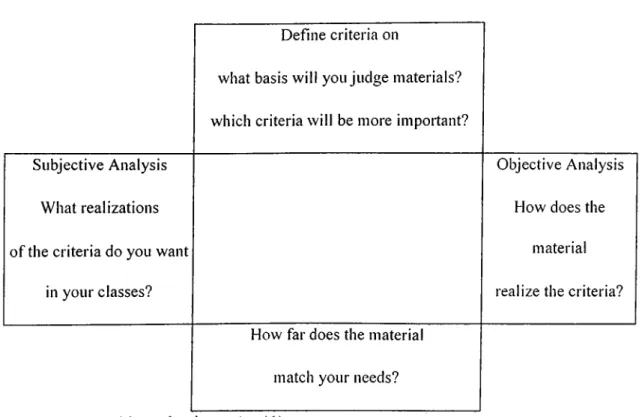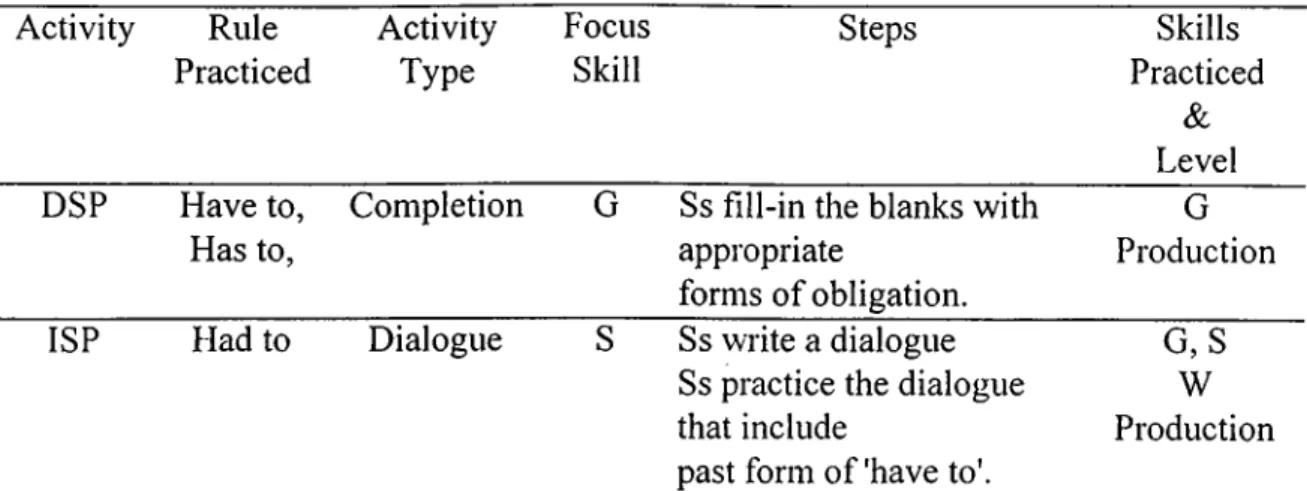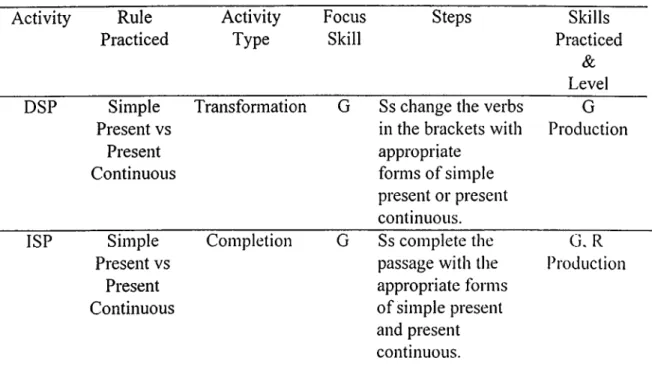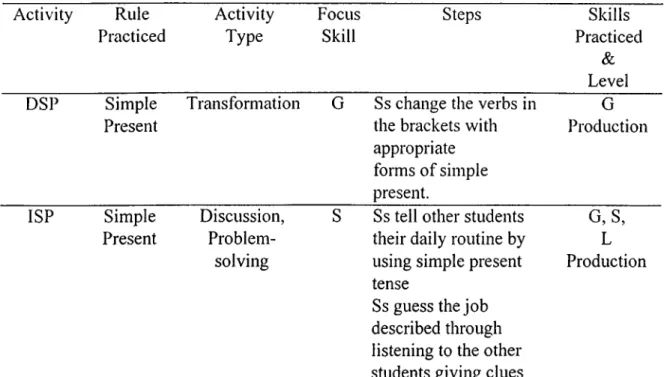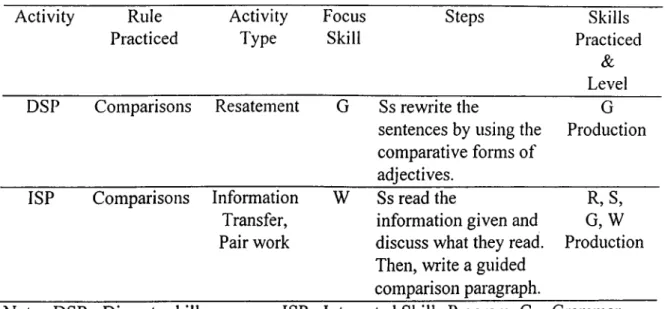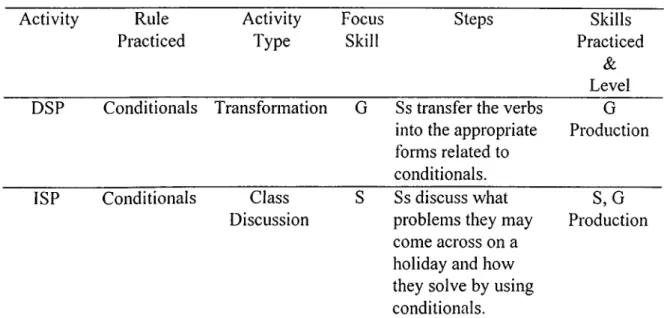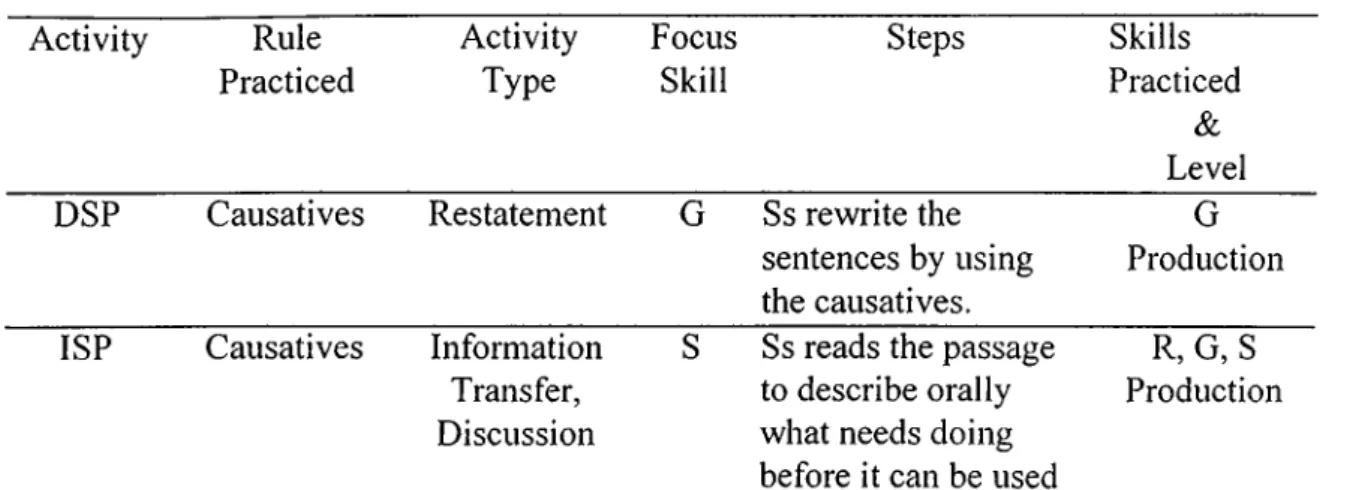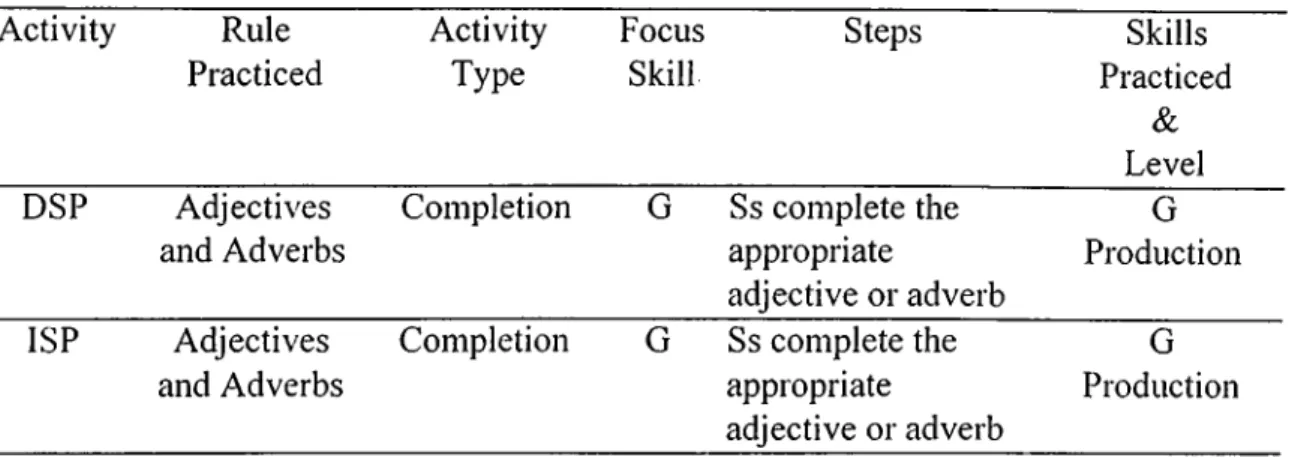THE INTEGRATED SKILLS PROGRAMS
AT OSMANGAZI UNIVERSITY
A THESIS PRESENTED BY
NURCAN PARLAKYILDIZ
TO THE INSTITUTE OF ECONOMICS AND SOCIAL SCIENCES
IN PARTIAL FULFILLMENT OF THE REQUIREMENTS
FOR THE DEGREE OF MASTER OF ARTS
IN TEACHING ENGLISH AS A FOREIGN LANGUAGE
BILKENT UNIVERSITY
DECEMBER 1997
i
0 6
S
THE INTEGRATED SKILLS PROGRAMS
AT OSMANGAZI UNIVERSITY
A THESIS PRESENTED BY
NURCAN PARLAKYILDIZ
TO THE INSTITUTE OF ECONOMICS AND SOCIAL SCIENCES
IN PARTIAL FULFILLMENT OF THE REQUIREMENTS
FOR THE DEGREE OF MASTER OF ARTS
IN TEACHING ENGLISH AS A FOREIGN LANGUAGE
BILKENT UNIVERSITY
t Oég TS Ps:h
Title:
Author:
Thesis Chairperson:
Committee Members:
Grammar Instruction in the Discrete Skills and Integrated Skills Programs at Osmangazi University
Nurcan Parlakyildiz
Dr. Bena Gül Peker
Bilkent University, MA TEFL Program
Dr. Patricia Sullivan Dr. Tej Shresta
Bilkent University, MA TEFL Program
The concern of this thesis was to identify the differences and similarities in grammar
instruction in a discrete skills program (DSP) in which grammar is taught separately and an
integrated skills program (ISP) in which grammar is taught an integrated manner. This
comparative study was conducted at the Department of Basic English that provides a one year
intensive English program at Osmangazi University Eskişehir, Turkey. The English program
in 1996-1997 switched from being a DSP to an ISP. The subjects were 13 English
instructors, ten of whom taught grammar in both the DSP and ISP, and three instructors only
in the ISP. Data were collected through the analysis of the curriculum documents and
textbook activities, administration of questionnaires observation of classroom presentations.
grammar teaching procedures in terms of the presentation, practice, correction and
evaluation stages in the DSP and ISP.
The analysis of the curriculum documents revealed that grammar is regarded as
crucial in the DSP while communicative skills are essential in addition to structural
proficiency in formal statements of objectives in the ISP. 7'hese objectives are realized
through a grammatical/structural syllabus in the DSP and a topical syllabus in the ISP.
Grammar testing is carried out through discrete point examinations in both the DSP and
ISP. Various kinds of drills and pattern-practice exercises are used in the DSP while
only multiple-choice questions are used in the ISP.
The textbook analysis showed that the DSP and ISP textbooks are different in
material design format. The DSP textbook is designed in a linear shape while the ISP
textbook is designed in a topical, linear and cyclic formats together.
'fhe analysis of textbook activities revealed that mechanical drills are preferred
b\' the DSP while communicative drills are mostly used in the ISP in addition to
mechanical drills. Isolated sentences are used in the DSP while contextualized exercises
are used in the ISP for grammar practice.
The analysis of the procedure of grammar teaching revealed both differences and
similarities. In the presentation stage, the native language was favored by the DSP
instructors and the target language was preferred b}' the ISP instructors. The DSP
and practice stages. Both DSP and ISP instructors revised the known grammatical rules
while explaining a new teaching point. The results of the study also revealed that
isolated sentences are used in the DSP whereas contextualization and authenticity of the
tasks were the two characteristics of the practice stage in the ISP. Errors in grammar
were usually corrected by the DSP instructors immediately and directly whereas the ISP
instructors usually preferred immediate and indirect correction in class. ‘Teacher
correction’ is mainly used in both DSP and ISP. In the ISP, peer and self correction
were also encouraged by the instructors. Mid-terms were the major evaluation
techniques used as formal testing to get feedback in the DSP and ISP. Another
similarity was that grammar was evaluated through discrete point examinations in both
MA THESIS EXAMINATION RESULT FORM
DECEMBERS!. 1997
The examining committee appointed by the Institute of Economics and Social Sciences
for the thesis examination of the MA TEFL student
Nurcan Parlakyildiz
has read the thesis of the student.
The committee has decided that the thesis of the student is satisfactory.
Thesis Title
Thesis Advisor
Committee Members
: Grammar Instruction in the Discrete Skills and Integrated skills Program at Osmangazi University
Dr. Tej Shresta
Bilkent University, MA TEFL Program
Dr. Patricia Sullivan
Bilkent University MA TEFL Program
: Dr. Bena Gul Peker
We certify that we have read this thesis and that in our combined opinion it is fully adequate, in scope and in quality, as a thesis for the degree of Master of Arts.
Tej Shresta (Advisor)
Bena Giil Peker (Committee Member)
. t c_.
. l i i
Patricia Sullivan (Committee Member)
Approved for the
Institute of Economics and Social Sciences
Metin Heper Director
ACKNOWLEDGEMENTS
I would like to express my gratitute Dr. Bena Gul Peker who graciously
contributed to my thesis with her ideas, support and soul; without her this thesis
would not have been completed.
I am indebted to Prof. Patricia Sullivan and Prof Theodore Rodgers for their
invaluable help and patience during my research study.
I am grateiiil to Prof Zckeriya Altaç for giving me permission to attend the
MA TEFL Program and to conduct my study at Osmangazi University. My thanks
also go to the preparatory instructors for their participation in the study.
1 would like to thank Fevziye, Aykut and Murat for their invaluable help and
big smiles on their faces.
My most special thanks are for İlker Acar without whom this thesis would not
have been possible.
My friends. Şebnem, Sevtap and 1. Sökmen deseive a special note of thanks
for their love, encouragement and support.
I am grateful to Müzeyyen and Armağan for their love, support, invaluable
help and co-operation. My special thanks arc extended to Aylin, Birol, Dilek, Elif,
Nilgun and Samer for their sweet hearts.
Finally, my greatest debt is to my parents and my brother without whom none
To
NATURE’S PRETTY SOUL
which inspires
TABLE OF CONTENTS
LIST OF TABLES... '... xi
LIST OF FIGURES... xiii
CHAPTER 1 INTRODUCTION General Introduction to the Study 1 Background to the Study... ... 3
Statement of the Problem... 6
Purpose of the Study... 6
Significance of the Study... 7
Research Questions... 7
CHAPTER 2 REVIEW OF LITERATURE Curriculum Design for Grammar Instruction 9 Different Models for Language Teaching Program Design. 9 Flistorical Overview of Grammar Instructional Methods.... 11
Review of Method Comparison Studies... 15
Key Theoretical Assumptions about the DSP... 21
Models for Instruction based on the DSP... 21
Key Theoretical Assumptions about the ISP... 23
Models for Instruction based on the ISP... 27
Objectives in Syllabus Statements... 29
Different Types of Syllabuses used in the DSP and ISP... 30
Instructional Materials and Activities in Grammar Instruction 32 Methods in Analysis of Language Learning Materials... 32
Stages of Evaluation... 34
Three Dimensions of Material Organization... 36
General Formats of Material Design... 39
Process-Oriented or Product-Oriented Materials... 40
Grammar Books versus Coursebooks... 42
Activity Types in the DSP and ISP... 46
Grammar Instruction Procedure 51 General Organization Models of Grammar Instruction... 52
Presentation of Rules... 53
Inductive versus DeductiveTeaching... 54
Use of Native or Target Language in Presentation of 56 Rules... Practice of Rules... 57
Contextualization of Grammatical Rules... 57
Authenticity of Texts and Tasks... 58
Sequencing of Rules in the Presentation and Practice Stages... 59
Error Correction... 60
Evaluation of Rules... 62
Materials... 65
Curriculum Documents... 65
Textbook and Activities... 66
Questionnaires... 66
Procedure... 68
Data Analysis... 68
CHAPTER 4 ANALYSIS OF DATA Introduction... 70
Analysis of Curriculum Documents... 70
Analysis of Objectives... 71
Syllabus Analysis... 72
Analysis of Written Exams... 77
Analysis of Instructional Materials... 80
Textbook Analysis... 80
Activity Analysis... 82
Analysis and Interpretation of Questionnaire Results about the Procedure... 97
Grammar Instruction in the DSP and ISP 99 Presentation Stage... 99 Practice Stage... 102 Correction Stage... 105 Evaluation Stage... 107 CHAPTER 5 CONCLUSION Introduction... 110
Overview of the Study... 110
Discussion of Findings... 111
Pedagogical Implications... 117
Limitations of the Study... 117
Suggestions for Further Studies... 118
REFERENCES... 119
APPENDICES... Appendix A: The Discrete and Integrated Skills 124 Questionnaire... Appendix B: DSP Syllabus... 131
Appendix C; ISP Syllabus... 132
Appendix D; The Linear Format... 133
Appendix E: The Modular Format... 134
Appendix F: The Cyclical Format... 135
Appendix G: The Matrix Format... 136
TABLE LIST OF TABLES PAGE
1 Brown’s Language Teaching Design... 11 2 American Studies Comparing Foreign Language Teaching.... 16 3 Degree of Superiority Shown in Comparative Method
Studies 17
4 GUME project Research Comparing Teaching Methods... 18
5 A Typical Structural Syllabus 22
6 Types of Syllabuses... 31 7 Exercise Chain Example... 49 8 The Real Life Skills Integration... 50
9 Types and Number of Questions 67
10 Comparison of the DSP and ISP Objectives in terms of
Grammar... 72
11 The DSP Syllabuses 73
12 The ISP Syllabuses 74
13 Comparison of the DSP and ISP Syllabuses in terms of
Grammar... 75 14 Comparison of the DSP and ISP Written Exams in terms of
Grammar... 79 15 The DSP Textbook Design... 81 16 The ISP Textbook Design... 81 17 Comparison of the DSP and ISP Textbook Activities in
terms of Grammar (1)... 84 18 Comparison of the DSP and ISP Textbook Activities in
terms of Grammar (2)... 85 19 Comparison of the DSP and ISP Textbook Activities in
terms of Grammar (3)... 86 20 Comparison of the DSP and ISP Textbook Activities in
terms of Grammar (4)... 88 21 Comparison of the DSP and ISP Textbook Activities in
terms of Grammar (5)... 89 22 Comparison of the DSP and ISP Textbook Activities in
terms of Grammar (6)... 91 23 Comparison of the DSP and ISP Textbook Activities in
terms of Grammar (7)... 92 24 Comparison of the DSP and ISP Textbook Activities in
terms of Grammar (8)... 93 25 Comparison of the DSP and ISP Textbook Activities in
terms of Grammar (9)... 95 26 Comparison of the DSP and ISP Textbook Activities in
terms of Grammar (10)... 96 27 Distribution of Mechanical and Communicative Activities in
the DSP and ISP... 97
29 Instructor Responses in Relation to Grammar Presentation in 100 the DSP and ISP...
30 Instructor Responses in Relation to Grammar Practice in the 103 DSP and ISP...
31 Instructor Responses in Relation to Grammar Correction in 106 the DSP and ISP...
32 Instructor Responses in Relation to Grammar Evaluation in 108 the DSP and ISP...
1 Anthony’s Language Teaching Design... 10
2 Richards and Rodgers’ Language Teaching Design... 10
3 Flarmer’s Views... 33
This section presents the general introduction and background to the study
and states the problem, purpose of the study, significance of the study and research
questions.
General Introduction to the Study
For many years grammar instruction has been an important concern for
researchers and language teachers. Widdowson (1979) argues that language cannot
be taught without its grammar. Grammar instruction models in different language
teaching programs have gained importance with the rediscovery of grammar in the
1980s (Bygate, Tonkyn & Williams, 1994; Bygate, Tonkyn & Williams, 1994).
Different language program designs require different teaching models where
different instructional materials and language learning activities are employed.
Some educationalists argue that grammar should be taught integratively with
other language skills (Ellis, 1993) while others (Johnson, 1973) assert that grammar
should have a separate place in the syllabus. The titles of many books stress
integration such as 'Interlink 1: a course in integrating skills in English' (Eckstut &
Miller, 1986 cited in Honeyfield, 1988). The titles and contents of some textbooks
written in the last 10 years reflect a growing interest in skills integration; however,
questions such as 'What does integration or segregation involve?' and 'Why do we
need integration or segregation of language skills?' continue to be debated by
goals are restated, basic language skills are re-emphasized and language is seen as a
whole. Language learning activities, instructional materials, the role of the teachers
and students and examinations as evaluation methods have been affected by these
changes.
In particular, there has been considerable discussion concerning discrete skill
versus integrated skill approaches to second language teaching (Enright &
McCloskey, 1988), given the fact that gaining a new language involves developing
all language abilities, such as listening, speaking, reading, writing and grammar in
several degrees and combinations (Oxford, 1990). Grittner (1982) argues that the
attempt to simplify language learning into separate parts like listening, reading or a
sequence of skills beginning with listening and speaking, to be followed by reading
and writing is wrong. In contrast. Manning (1990) argues that all language skills
may not given equal importance and some skills can be ignored or not paid attention
to completely.
The discussion concerning the teaching of discrete skill versus integrated
skill approaches has important implications for language teaching programs. The
important issues in surveying a language teaching program seem to be: first,
“whether the materials are in harmony with the syllabus in terms of procedures,
techniques and presentation of items and objectives”, second, “whether the
materials provide alternatives for teachers and learners in terms of learner-tasks”,
included in the materials are authentic”, fifth, “whether the language learning
activities are contextualized”, and sixth, “whether materials suggest certain roles for
teachers and learners in error correction” (Dubin & Olshtain, 1986, p. 27). These
issues were taken into consideration in surveying the possible differences and
similarities in the DSP and ISP.
Background to the Study
This section describes the current situation in the Department of Basic
English at Osmangazi University with respect to grammar instruction in the discrete
skills program (DSP) and integrated skills program (ISP).
This study was motivated by the researcher’s experiences as a teacher at the
Department of Basic English in Osmangazi University. Osmangazi is a new
university which was established in 1993. Despite its relative newness, the
Department of Basic English has already used two seemingly dramatically different
approaches to grammar instruction- the discrete skills program (DSP) and the
integrated skills program (ISP).
The DSP was used from 1993-1996. The ISP was used for only the 1996-
1997 academic year after a formal survey for program development. The survey was
motivated by the staff opinions expressed in group meetings and the results of
informal student surveys investigating the reactions to the courses in the classes and
the textbooks were different for each skill and the topics and grammatical foci were
too different in each program. For example, they were studying obligations in the
writing class while the simple present tense was covered in the grammar class.
Thus, there seemed to be in consistencies in language teaching. The third complaint
was about examination weeks. Since examinations were conducted separately
throughout the week, they had reading, listening, grammar, writing and speaking
examinations. As a result, the students found the exam week long and tiring. In
fact, many students were not able to continue classes the week following the exam
week because they felt tired. The last major issue was that especially for
unsLiccsessful students or for those who did not like one of the classes, such as
writing there was no other focus skill to motivate them. Since the majority of the
staff and the administrator agreed with the students as to what was reported in staff
meetings, it was decided to conduct a ‘program development’ survey.
This survey was conducted by two instructors working in the Program
Development Unit with the aim of finding out the different ways that grammar
instruction was implemented in the DSP and ISP in terms of the overall curriculum,
existing instructional materials, teaching methods, and evaluation techniques. They
consulted six universities, Hacettepe, METU, Boğaziçi, Bilkent, Anatolian and
Karadeniz Technical Universities, all of which are English medium universities.
The findings of the program development survey revealed that there is no
syllabuses, for example in the Anatolian and Karadeniz Technical Universities, it is
taught in an integrated manner in other in other universities, such as METU,
Boğaziçi, Bilkent and Hacettepe Universities in Türkiye. Moreover, the findings
showed that the traditional organization of instruction by discrete skills is giving
way to the so-called integrated skills approach. For instance, at Boğaziçi University
language program was changed from the DSP to ISP.
A general picture of the DSP and ISP in these six universities was provided
through the Program Development survey. According to the survey, the DSP and
ISP differed in the following ways:
1. In the DSP, each language skill has an independent syllabus while in the
ISP, five language skills (listening, speaking, reading, writing and grammar) are
integrated into one syllabus.
2. In the DSP, each language skill has an independent textbook while in the
ISP, all language skills are included in the same textbook series.
3. In the DSP, each language skill is evaluated separately in examinations
while in the ISP language skills are evaluated in the same exam sheet through
separate sections, such as the grammar section.
4. In the DSP, there is a focus skill in each course, such as writing in the
‘writing’ course while in the ISP, one or more skills can be focused on in the same
to motivate this study.
Statement of the Problem
As stated earlier, although there has been considerable discussion in recent
years about discrete skills versus integrated skills approaches to second language
teaching, and there has been no research on the differences and similarities in the
two programs in terms of grammar instruction in Turkey.
The teacher and material evaluation questionnaires administered to the
students at Osmangazi University in 1995-1996 indicated that students became
bored and were unsuccessful at classes which they did not like. As a result of the
segregation of language skills, different language units and structures are
emphasized at the same time which was found confusing by the students, 'i'o
investigate this issue, it is necessary that the syllabus, objectives, textbooks, other
instructional materials and evaluation techniques be examined.
Purpose of the Study
The purpose of this study is to find the differences and similarities in
grammar instruction within the DSP, in which the language skills are taught
separately, and the ISP, in which the language skills are integrated with each other,
skill approaches to teaching a foreign language. This enthusiasm has not been
accompanied by evidence showing the superiority of one approach over the other.
Hence, in many cases, the differences between the two approaches are not clear.
Before any effectiveness data can be gathered, a clear understanding of the
differences in design and delivery of the two program types needs to be developed.
Identifying the differences and similarities in the DSP and ISP is a necessary
step in suggesting one program type or another to the administrators, the instructors
and the students at the Department of Basic English in Osmangazi University,
Eskişehir. It may also help other universities which are faced with such
programmatic changes.
Research Questions
This comparative study was carried out with reference to curriculum
documents, textbook activities and instructors’ opinions. The concern of this thesis
was to find the answer to the following questions:
1. What are the differences and similarities between the DSP and ISP with respect
to grammar instruction in terms of the presentation, practice, correction and
evaluation stages.
2. What are the differences and similarities between the DSP and ISP with respect
to curriculum documents?
instruction and materials in terms of grammar will be reviewed in the following
This comparative study seeks to examine the similarities and differences in
grammar instruction in the DSP and ISP at the Department of Basic English in
Osmangazi University. In this chapter, a review of literature with respect to
curriculum design, instructional materials and procedure in terms of grammar
instruction will be presented.
Curriculum Design for Grammar Instruction
This section presents different models for language teaching program design,
historical overview of grammar instructional methods, a review of method
comparison studies, key theoretical assumptions about the discrete skills program
(DSP) and integrated skills program (ISP), models for instruction based on the DSP
and ISP, objectives in syllabus statements and different types of syllabuses used in
the DSP and ISP.
Different Models for Language Teaching Program Design
Anthony, Rodgers (Richards & Rodgers, 1986) and Brown (1995) suggest
three different models for the design of language teaching . According to Anthony’s
(Richards & Rodgers, 1986) model, “approach” is a correlative assumption dealing
with the nature of language teaching and learning, “method” is an overall plan that
directs the syllabus for the orderly presentation of language material and “technique”
Approach Method Technique
Figure 1. Anthony's language teaching design (Richards & Rodgers, 1986, p. 15)
In Rodgers' (Richards & Rodgers, 1986) model, “approach” includes a theory
of language and a theory of language learning; “design” includes objectives, syllabus
model, learning and teaching activities, the roles of teachers, learners and
instructional materials; and “procedure” specifies classroom techniques and
practices. Approach, design and procedure are all situated under method as is shown
in Figure 2.
METHOD
Approach Design Procedure
a) A theory of the nature a) The general and a) Classroom techniques,
of language specific objectives of the practices and behaviors
b) A theory of the nature method observed when the
of language learning b) A syllabus model method is used
c) Types of learning and
teaching activities
d) Learner roles
e) Teacher roles
f) The role of
instructional materials
In addition to these models, Brown (1995) suggests another model in which
approaches specify how the needs of the students are viewed or defined, syllabuses
determine how the materials and teaching are organized, techniques identify how the
language is presented to the students while exercises identify how the language is
practiced. Table 1 shows Brown’s language teaching design.
Table 1
Brown’s Language Teaching Design (Brown, 1995, p. 5)
Categories Definitions
Approaches Ways of Defining What and How the Students Need to Learn Syllabuses Ways of Organizing the Course and Materials
Techniques Ways of Presenting the Materials and Teaching Exercises Ways of Practicing What Has Been Presented
Rodgers’ (1986) design with regard to the general and specific objectives,
syllabus models, types of learning and teaching activities, instructional materials and
procedure that focuses the presentation, practice and feedback phases of teaching
motivated the research questions that will be examined in the data analysis chapter of
this research study.
Historical Overview of Grammar Instructional Methods\
Throughout centuries, the study of a language has meant primarily the study
of its grammar. This perspective continues today. However, the term grammar is
used and defined in different ways by different people. While Pence and Emery
(1963) define grammar as a central part of language which relates to sound
(phonology) and meaning (semantics), Dowen (1985) defines it as the study of
sentences (syntax). In the Structure of American English (Ozen, 1985), grammar is
further defined as " the branch of linguistics which deals with the organization of
morphemic units into meaningful combinations larger than words" (p. 85).
As Ward (1933) argues:
definitions in grammar are provisional, are mere statements
of what is typical and usual; they are not, they cannot be,
all-inclusive containers of the full truth about the parts of
speech. A definition is only a convenience, exceptions
and anomalies will crop out later...A definition is not
an eternal truth. It is a preliminary and partial statement
of what is characteristic.
(p. 145)
This quote indicates that there is no a common definition of grammar. It is not
surprising that different approaches were developed for grammar instruction in
different language teaching designs.
In the supremacy period of grammar, conscious control of grammar was held
necessary for foreign language mastery by the Grammar-Translation Method.
Translation and grammar activities were the two essences of language learning.
Grammar was taught deductively and exercises were designed to provide practice on
the grammar (Richards & Rodgers, 1986).
The successors to this method in the first half of the twentieth century refused
grammatical knowledge as a focus; however, they saw their task as the transmission
writing within the American Audiolingual tradition argued for "control of the
structures of sound, form and order in the new language" (p. 9). In the Audio-
Lingual method, pattern drills are not taught with explanations as Palmer (cited in
Richards & Rodgers, 1986) thinks explanations of the rules may be a waste of time
and are given if necessary. According to Diller (1978) new structures are presented
with the dialogues since the most important consideration of the Audio-Lingual
Approach is that structures are better learned and mastered in context rather than the
study of isolated grammatical structures. Lado (cited in Krashen, 1982) notes that
audio-lingual pattern drills focus the students’ attention away from the new structure
to make the pattern automatic. Thus, the rules are not given deductively, but induced
from examples (Freeman, 1986; Celce-Murcia, 1991).
Although a 1971 British guide to teachers of EFL had no separate section on
grammar; grammar has a key position almost in all the chapters of the guide (Wilson
& Wilson, 1971). The Chomskyan revolution in linguistics kept grammar at the
center of linguistic interest, but it may be said to have created a climate in which a
revival of mentalist or cognitive approaches to language pedagogy was easier. The
name of one of these approaches, the Cognitive Code method, reflects continuing
concern with the language system and it is significant that Carroll (cited in Bygate,
Tonkyn & Williams, 1994) saw the Cognitive Code method as a kind of updated
grammar-translation approach. In the Cognitive Code method, the assumption that
“competence precedes performance” (Krashen, 1982, p. 32) indicates that “once the
student has a proper degree of cognitive control over the structures of a language,
(Carroll, 1966; Bygate, Tonkyn & Williams, p. 35). After the rule is presented,
exercises help the student practice the rule consciously and are followed by
communicative activities. On the other hand, the Direct method emphasizes
inductive teaching as Prator (1979) points out: “the rule generalization comes only
after experience” (p. 25). The teacher asks questions that are hopefully interesting
enough to provide an example of the target structure since the goal of the lesson is
grammar teaching.
The Language for Specific Purposes movement which began in 1969 under a
strong structural influence, seeking to answer the question: “What selection from the
grammar will be of most use to a scientist” turned to the functional /notional
approach which asks: “What types of communicative event will our students engage
in?” (Bygate, Tonky & Williams, 1994, p. 5). In addition, sociolinguistic and
psycholinguistic awareness played an important role in the decline of the grammar in
foreign language course design and methodology. Form-focused instruction was
marginalized by (1) Chomsky's (Bygate, Tonkyn & Williams, 1994) conception of
the language learning through a language acquisition device (LAD), (2) the order of
children's acquisitional regularities which are similar to those revealed by the LI
researchers of morphological features, morpheme acquisition studies (Dulay & Burt,
1973, 1974; Bygate, Tonkyn & Williams, 1994) and, (3) Krashen's (1982) hypothesis
of second language acquisition which proposes a move away from teaching grammar
deductively marginalised the role of form-focused instruction. By the early 1980s, in
mother tongue and in foreign language teaching, grammar had lost its central
presentation of grammar, but discussion of personal topics. In the late 1970s, the
notion of communicative competence, in which grammar was “one of several criteria
set up for the assessment of effective speaking and writing” (Bygate, Tonky &
Williams, 1994, p. 4) and communicative success did not necessarily depend on
accurate grammar, tended to play down the value of grammar.
Some educationalists such as Edwards and Mercer (cited in Bygate, Tonky &
Williams, 1994) argued in favor of deductive teaching of concepts and against
excessive use of discovery learning since there was an apparent decline in standards
of written English among university graduates. In the 1970s and 1980s many
English language coursebooks appeared in which lesson headings and objectives
were stated in functional terms with grammar points in language study sections at the
end of the lesson or unit. With some innovative methods such as Total Physical
Response in which several rules are contextualized in commands and Suggestopedia
in which the necessary grammar is presented in a traditional way, the rediscovery of
grammar has started (Bygate, Tonky & Williams, 1994).
Review of Method Comparison Studies
The variety of language teaching methods have prompted numerous
comparative studies. These studies have compared the audiolingual approach with
either Grammar Translation (GT) or Cognitive Code (CC). Table 2 summarizes
several American comparison studies related to foreign language teaching in the
T a b le 2 , A m p. ri ea T ^ Stud ies Com naring Fore ign L an g u a g e T eac h in g M e thods (Kras hen , 1 9 8 2 , p . 14 8) _ S tu d y Schcrer & W e rt he im er C h a st a in S c W o e r d e h o ff ' M u e ll e r M et h o d s T L T ests; Sp eak ing L C R e a d in g W r ite A tt it u d e to ward m e th o d G T .A L C C ,A L C C .A L G erm an S p a n is h French 1 3 0 ,1 5 0 5 1 ,4 8 3 5 ,3 1 Y e a r 1 Y e a r 2 Y e a r 1 Y e a r 2 A L n d AL AL not given A L A L nd nd CC GT nd CC nd CC GT GT CC nd CC A L A L CC (f e w e r d r o p o u ts ) A L = a u d io -l in g u a l G T = gra m mar-translati on CC = c o g n it iv c -c o d c n d = n o d if fe r e n c e , ’ In cl u d es bo th Chastain & W o e r d e h o ff (1 9 6 8 ) and Cha sta in ( 1 9 7 0 ).
Scherer and Wertheimer’s (cited in Krashen 1982) studies showed no
significant differences between the Audio-Lingual (AL) and Grammar Translation
(GT) methods. It was concluded that students tend to do well in those areas that are
emphasized in the teaching method.
Chastain and Woerdehoff (cited in Krashen, 1982) and Chastain (cited in
Krashen, 1982) found similar results after comparing GT and CC, but Chastain (cited
in Krashen, 1982) also stated males tended to do better with AL, while females did
better in CC sections. Mueller (cited in Krashen, 1982) limited his study to one year
and the results showed that those skills that tested CC were superior while
audiolingual (AL) classes are at national norms. This advantage may be due to
length of time. Table 3 gives some idea as to the degree of superiority shown by one
method over another (Krashen, 1982, p. 150).
Table 3
Degree of Superiority Shown in Comparative Method Studies (American Series)
Cooperative Tests: Reading! Writing 1 Listening comp Speaking2
AL 26 59 25 51
CC 30 64 26 49
Note. 1= Significant difference in favor of CC, 2= Significant difference in favor of AL. (From: Chastain and Woerdehoff, 1968)
Both methods resulted in some progress and showed only occasionally significant
differences. Although the results are not very different, the -differences are
significant.
Another study which is called as the GUME project aimed to compare AL
'c ac h in .q M ethods (K ras hen , 1 9 8 2 , p. 1 5 2 -15 3 ) S tu d y M e th o d S tu d e n ts M a te ri a ls R e su lts O ls so n , 19 69 Implicit^ EX S w e d is h E X E n g li sh A g e 1 4 O n e .s tru ct u re (p a ss iv e ) N o d if fe r e n c e s L e v in , 1 9 7 2 Im p li c it E X E n g li sh E X S w e d is h A g e s 1 4 -1 5 N o o v er a ll d if fe r e n c e ; “ a d v a n c e d ” gr ou p c.xc el ls in E X S w ed is h L e v in , 1 9 7 2 Im p li c it E X S w e d is h E X E n g li sh A g e 1 3 N o ov er a ll d if fe r e n c e ; m o r e “a b le ” st u d e n ts d o w e ll ' w ith E X S w e d is h , but le ss ab le d o wor se V o n E le k & O sk a r ss o n , 1975 IM ^ E X A d u lt s n = 1 25 T e n l e ss o n s E X P L IC IT s ig n if ic a n tly b e tt e r V o n E le k & O sk a r ss o n , 1975 IM EX A d u lt s n = 9 1 A s a b o v e E X P L IC IT s ig n ifi c a n tly b e tt e r V o n E le k & O sk a r ss o n , 1975 IM EX A g e 1 2 A s a b o v e N o d if fe r e n c e , d u e to lo w p e r fo r m a n c e o f o n e E X P L IC IT class V o n E le k O sk a r ss o n , 1 9 7 5 E X ,I M , E X IM . IME X·’ A d u lt s n = 2 7 7 4 l e ss o n s o n 2 str uc tu r es E X su p e ri o r to IM ; IM E X b et ter th a n IM , b u t no t si gn ifi ca nt ; E X s u p e r io r to E X IM (no t p r e d ic te d ) V o n E lc k cR : O sk a r ss o n , 197 5 E X .I M , E X IM .I X E M A g e 1 2 n = 3 3 5 4 l e ss o n s o n 2 st r uc tu r es G ir ls tend to c o n fo r m to the ad u lt patt ern (s e e a b o v e ) bu t b o y s d o not ' IM = " im p li c it " ( p a tt e r n d ri ll s o n ly ). E X = " c. x p li ci t" ( p a tt er n s d ri ll s in c o m b in a ti o n w it h e x p la n a ti o n ). E X S w e d is h = e x p la n a ti o n i n S w e d is h . IZ X Ii n g li sh = c x p la n a ii o n i n E n g li sh . ‘ IM = " st m c u ir c d a n d g ra d e d p n ii cr n d ri ll s, p e r fo r m e d o n i h e b a si s o f si u ia ii o n a l p ic tu r es p r o je c te d o n a s c r e e n i n f ro n t o f th e cl a ss . .. n o e x p li ci t e x p la n a ti o n s, c o m p a r is o n s w it h th e so u r c e l a n g u a g e , o r tr a n sl a ti o n e x e r c is e s” ( v o n E le k a n d O sk a r ss o n , 1 9 7 5 , p . 1 6 ). E X = “ st u d e n ts w e r e g iv en cx () li ci t in fo r m a ti o n a b o u t i h .c s y n ta c ti c ch a r a c te r is ti c s o f th e st ru ct u re s b e in g p r a c ti c e d . .. c o m p a r is o n s w e r e m a d e w it h t h e co r r e sp o n d in g s tr u ct u re s in S w e d is h . . . g r a m m a r w a s ta u g h t d e d u c ti v e ly . . . e x p la n a ti o n s a n d d ir e c ti o n s w e r e g iv e n b e fo r e m a in p ra ct ic e w it h t h e st ru ct u re u n d e r s tu d y . .. e x e r c is e s w e r e m o st ly of t h e fi ll -i n t y p e o r tr a n sl a ti o n . .. n o p a tt er n d ri ll s w e r e p e r fo r m e d ” (v o n E le k a n d O sk a r so n , 1 9 7 5 , p . 1 6 -1 7 ). IM E X = id e n ti c a l to I M w it h t h e a d d it io n o f c x [d a n a li n n . E X IM = id e n ti c a l to E X w it h a d d it io n o f o ra l p a tt er n d ri ll s.
The GÜME project found no differences between what they termed ‘implicit’
methods (similar to AL) and ‘explicit’ methods (similar to'CC) for adolescent
subjects. For adult subjects, explicit methods were found to be better. In addition to
simple comparisons of explicit and implicit methods, Von Elek and Oscarsson (cited
in Krashen, 1982) found that adding some grammatical explanations to a method
based on only pattern drills was helpful. However, adding pattern drills to a
cognitive approach did not help.
Swedish studies, like American studies, show only small differences. Stevick
(cited in Krashen, 1982) noted the implicit contradiction by stating that “in the field
of teaching. Method A is the logical contradiction of Method B: if the assumptions
from which A claims to be derived are correct, then B can not work, and vice-versa.
Yet one colleague is getting excellent results with A and another is getting excellent
results with B. How is this possible?” (p. 151 ). Krashen (1982) interprets the results
by saying that AL, GT and CC do not encourage ‘subconscious’ language acquisition
and cognitive methods will allow more learning.
In relation to newer methods, Asher (cited in Krashen, 1982) compared Total
Physical Response (TPR) to other methods using children and adults in foreign
language classes and second language classes.' After 32 hours of TPR for the adult
learners in a TPR German course with controls in a standard college course, TPR
students outperformed controls, who had had 150 hours of classtime, in a test of
listening comprehension, and equalled controls in tests of reading and writing.
Interestingly, Asher’s (cited in Krashen, 1982) students progressed nearly five times
small differences seen in in older comparative method experiments comparing AL,
GT and CC.
Asher, Kusudo and de la Torre (cited in Krashen, 1982) compared TPR
students studying Spanish at the university level with AL controls. After 45 hours of
TPR instruction, students outperformed controls who had had 150 hours in listening
comprehension, and equaled controls’ performance on a reading test. In another
study (cited in Krashen, 1982) comparing TPR to GT, showed that TPR students
outperformed controls who had had the same amount of training (120 hours) but who
had started at a proficiency level class. Furthermore, in an experiment of TPR with
children at sixth grade and a class consisting of seventh and eight grade students to
ninth grade during 40 hours of classtime. All seven different classes exceeded the
controls on the test of written production. Thus, it was striking that TPR classes
were superior to controls.
A variety of studies have been done examining the efficacy of methods such
as TPR that focus on providing comprehensible input and do not force early
production. Gary (cited in Krashen, 1982), Postovskey (cited in Krashen, 1982)
studies and Swaffer and Woodruff s (cited in Krashen, 1982) study depends on
‘comprehensible input’ which was evaluated in several ways indicated that input
based methods were superior to the others.
In addition to TPR studies, Krashen (1982) reports that there have reports of
students learning 1000 words per day using Suggestopedia. Bushman and Madsen
(cited in Krashen, 1982) conducted a Suggestopedia experiment at Bringham Young
Key Theoretical Assumptions about the DSP
In traditional language programs language skills; that is to say, listening,
speaking, reading, writing and grammar follow each other and are taught separately.
In spite of the theoretical arguments for or against this decision, the discrete skills
programs have reflected the conventional organization of English courses in the
universities for years, for example, in Thai universities.
There are various assumptions concerning the teaching of the DSP. Crandall
and Peyton (1993) state that there is a set hierarchy of skills. In other words,
productive skills should be taught after receptive skills. Asher’s (cited in Richards &
Rodgers, 1986) emphasis is on developing comprehension before production, that is,
“the teaching of speaking should be delayed until comprehension skills are
established” (p. 36). Several different comprehension-based language teaching
proposals (Audio-Lingual, TPR) share the same idea that comprehension abilities
precede productive skills in learning a language (Richards & Rodgers, 1986).
Another assumption is that all language skills are given equal importance in
the DSP unlike the ISP in which listening and speaking skills are ranked as number 1
and 2 in importance, while reading and writing are ranked as numbers 3 and 4.
Therefore some skills can be ignored or paid less attention to for the sake of others
(Manning, 1990).
Models for Instruction based on the DSP
Discrete skills programs in which each language skill, listening, speaking,
and skills-based syllabuses. Many textbooks and classroom materials haVe been
organized according to a structural syllabus which is emphasized in Situational or
Oral approach and Audiolingual method. The focus is on the grammatical content in
a structural syllabus which is centered around grammatical items, such as tenses,
articles, singular-plural, complementation and adverbial forms. According to French,
(cited in Richards & Rodgers, 1986) “The fundamental is correct speech habits. The
pupils should be able to put the words into sentence patterns which are correct” (p.
57). A structural syllabus is a list of the basic structures and sentence patterns of
English. The following example of the typical structural syllabus, in which lessons
are organized around different grammatical structures, is given by Frisby (cited in
Richards & Rodgers, 1986).
Table 5
A Typical Structural Syllabus (cited in Richards & Rodgers, 1986, 13)
Sentence pattern Vocabulary
1 S t lesson This is ... book, pencil, ruler.
That is . . . desk.
2nd lesson These are... chair, picture, door,
Those are... window.
3rd lesson Is th is...? Yes, it is. watch, box, pen. Is that...? Yes it is. blackboard
The Audio-Lingual method is an example of a structure-based approach to
language teaching and sentence patterns and grammatical structures are important as
aspects of language learning. Learning a language, therefore, means learning its
rules” (Richards & Rodgers, 1986, 13).
The DSP approach may also use a skill-based approach. The Situational
Approach, for example, aims at teaching all basic language skills, however, through
‘structure’ as in many other syllabuses. Similarly, in the Audio-Lingual method,
language skills are equally given importance after having a mastery of aural and
pronunciation abilities. The traditional way of teaching is followed: receptive skills
(listening, speaking) are followed by productive skills (reading, writing) (Richards &
Rodgers, 1986).
A skills-based syllabus organizes materials around the language that the
students will most need in order to use and continue to learn the language. For
instance, a reading course might include such skills as skimming; reading for the
general idea, scanning; reading for specific information, guessing vocabulary from
context, using prefixes, suffixes and roots and finding main ideas. It can thus be seen
that the DSP may have both a structural and skills-based syllabus (Brown, 1995).
Key Theoretical Assumptions about the ISP
Over the last ten years, views and several assumptions regarding English as a
foreign language instruction have changed significantly and new methods have
emerged for helping students develop proficiency in English as a second language.
There has been a move away from teaching isolated skills to teaching language as a
whole and in an integrated approach. Widdowson (1978) states th at" if the aim of
reasonable to adopt an integrated approach to achieve it” (p. 144).
The first assumption is that according to psychological and practical reasons
for the integration of skills in language learning, there is a large overlap among the
language skills; listening, speaking, reading writing and grammar and in real-life
communication, there is frequently alternation between receptive and productive
activity as opposed to that comprehension abilities proceede productive skills
(Abbot, 1981; Bygate, Tonkyn & Williams). Many scholars have commented on the
positive relationship between all language skills. It is assumed that to perform one
skill without another is impossible. While dealing with one skill, we deal with
another skill (Harmer, 1984). Arapoff (1965) supports Harmer (1984) by arguing
that grammar, listening, reading, and speaking are requirements for developing
writing. The assumptions reflected in the work of Hymes, Munby, Brumfit and
Widdowson (cited in Hudelson, 1993) suggest that language teaching should
emphasize integration as opposed to the separation of traditional skills areas since
authentic language use often involves the use of more than one skill. Likewise,
Johnson (1973) recommended that basic communication skills course should be
integrated skills package.
A second assumption is that what is taken in through more than one channel
is more likely to be learned well. That is, the different channels can reinforce one
another (Widdowson, 1979). Success in language learning depends basically on the
mastery of listening, speaking, reading and writing skills in a second language.
Evans (1989) believes that
entities for the sake of instruction is neither pedagogically
sound nor an efficient use of time. It also puts
the students... at cross purposes with the instructor
and the cumculum, thereby creating an unhealthy
environment for optimum language learning by
dampening the students motivation, a major factor
in second language acquisition.
(p. 8)
Evans (1989) argues that an intensive university level English course which
was designed to prepare foreign students to enter American universities and compete
successfully with American students showed that "designing lessons which integrate
the skill areas of listening, speaking, reading and writing is not only a more natural
and realistic approach to language learning, but also provides that no skill area will
be slighted” (p. 9). This integrated skills curriculum stimulated students to read and
write while allowing opportunities to develop the speaking and listening skills which
students feel are an essential part of their second language education.
A third assumption, according to Enright and McCloskey (1988) is that "if the
whole of language is greater than the sum of its parts and if the whole of the process
of language learning is also greater than the sum of its parts, then instruction should
be organized in an integrated way" (p. 26). For example. Manning (1990) mentions a
research study which aimed at comparing writing skills of the students in an ISP in
which all language skills are presented together with the other students in a discrete
who view themselves as writers of real texts and had confidence in themselves as
writers. The key theoretical assumptions of the integrated language teaching model
accept language as having a limitless capacity to make meaning and therefore should
not be broken down and taught as tiny discrete skills. Students need multiple
opportunities both to take in (i.e., listen and read) and to give out (i.e., speak and
write) this real language in order to become successful second language
communicators and thinkers. Enright and McCloskey (1988) argue that
students develop language and literacy as part of
a broader process of semiotic or meaning- making
development. They do this through using the processes
of listening, speaking, reading and writing in concert
with one another rather than separately. Thus the
development of each language process can support
the development of the others (language skills)
(p. 19).
The fourth assumption supports skills integration by arguing that people have
different learning abilities and that they learn through the ear, the eye and muscular
movement. The integration of language skills is summarized by Alexander (1967)
saying that:
Nothing should be spoken before it has been heard.
Nothing should be read before it has been spoken
Nothing should be written before it has been read.
Another assumption that presents an organic view of grammar learning is
presented by Rutherford (1987) criticizing the linear conception of grammar learning
as discrete grammatical points or separate parcels in some grammar textbooks that
follow the building-block view of grammar learning, for example, the present simple
proceeding the simple past tense. For learning grammar progressively as a system, it
is better to learn grammar in terms of a cyclic progression; "revisiting, developing
and enriching what one has already learned, elaborating new and related knowledge
as one goes, and building a sense of the interrelatedness of choices" (1987, p. 19).
Thus, grammatical knowledge evolves organically rather than growing in discrete
steps.
Models for Instruction based on the ISP
There has been a movement away from narrow methods to broader integrated
approaches in language teaching in the past decade. Various models are used in an
attempt to achieve integration of skills. These models include the teaching of all
basic language skills with structures and communicative goals in a new holistic view.
Snow (cited in Celce-Murcia, 1991) argues for content-based language in
which language is best learned when it is used as a means to accomplish some other
purpose. The rationale for content-based instruction is explained by Swain (cited in
Celce-Murcia, 1991) as “in addition to comprehensible input, students must produce
comprehensible output” (p. 316). Thus, all basic language skills are used in content-
based approach.
Celce-Murcia, 1991). This model is based on selected pieces of literature in the target
language whieh are used as eontent for language learning practice. The mastery of
the voeabulary and grammar of the language with other language skills is provided
by literature. All these skills are praeticed by reading of literary work.
Lastly, Eyring (eited in Celce-Murcia, 1991) emphasizes using the learner’s
experienee as a basis for language learning. Experiential learning is derived from
natural aetivities where both the left side and right side of the brain are engaged
(Danesi, 1988; Celee-Murcia, 1991), content is contextualized (Omaggio, 1986,
Celce-Mureia, 1991), skills are integrated (Moustafa & Penrose cited in Celce-
Murcia, 1991) and purposes are real (Cray, 1988; Celce-Murcia, 1991). Counseling
learning, cooperative learning, task-based learning, content-based learning, whole-
language approach, the natural approach, language experience approach and English
for Specific Purposes can be considered as integrated approaches. The most
important point is that, in all these ISP approaches, ‘basic language skills’ are
promoted in addition to language development in ‘grammar’ and ‘vocabulary’.
In addition to Content-based, Literature model and Experiential learning, the
Communicative Approach has produced profound changes, particularly in the
product area in which interest in the language skills has been re-emphasized. In
terms of practical implementation learning and teaching do not stop with only one
language skill. The speaking, listening, reading and writing skills are re-defined in
terms of the communicative goals. Unlike the ‘discrete element view of language’,
partieularly in audiolingual and cognitive-code approaches, in the communieative
topical content and lexis in a ‘holistic view’ (Dubin & Olshtain, 1986). Topical
syllabuses and thematic syllabuses are organized around topics, such as divorce,
single parents, abortion, crime, terrorism, nuclear disasters and others.
Objectives in Syllabus Statements
No matter what type of syllabus is used, there are generally three primary
concerns of a syllabus: 1) language content, 2) process or means, and 3) product or
outcomes. According Dubin and Olshtain (1986) course designers ask ‘key’
questions such as the following:
1. What elements, items, items or themes of language content should be selected for
inclusion in the syllabus?
2. In what order or sequence should the elements be presented in the syllabus?
3. What are the criteria for deciding on order of elements in the syllabus?
(p. 42)
If a syllabus is strictly based on a particular philosophy of education, another set of
questions should be asked about the process dimension:
1. How should language be presented to facilitate the acquisition process?
2. What should the roles of teachers and learners be in the learning process?
3. How should the materials contribute to the process of language learning in the
classroom?
important.
1. What knowledge is the learner expected to attain by the end of the course? What
understandings based on analyses of structures and lexis will learners have as an
outcome of the course?
2. What specific language skills do learners need in their immediate future, or in
their professional lives? How will these skills be presented in the syllabus?
3. What techniques of evaluation or examination in the target language will be used
to assess course outcomes?
(Dubin & Olshtain, 1986, p. 42)
In all syllabuses that direct language programs, specific objectives are stated
implicitly or explicitly according to the syllabus des|gn.
Different Types of Syllabuses used in the DSP and ISP
A syllabus is generally defined as a way of organizing courses and materials.
Different language programs are designed from different syllabuses. The familiar
structural syllabus which is centered around items such as tenses, articles and the like
is called as ‘traditional’ until functional and notional syllabuses exist (Dubin &
Olshtain, 1986). After the structural syllabus, language teaching programs were
designed around many different syllabuses (Salimbene, 1983). McKay (1978)
defines three types of syllabuses; structural, situational and functional syllabuses. In
addition to these three syllabuses. Brown mentions four other types of syllabuses:
topical, notional, skills-based and task-based syllabuses. Table 6 presents all
Table 6
Types of Syllabuses (Brown, 1995, p. 7).
Categories Definitions
Syllabuses Ways of Organizing Courses and Materials
Structural: Grammatical and phonological structures are the organizing principles-sequenced from easy to difficult or frequent to less frequent.
Situational: Situations (such as at the bank, at the supermarket, at the restaurant, and so fort) form the organizing principle, sequenced by the likelihood students will encounter them (structural sequence may be in background).
Topical: Topics or themes (such as health, food, clothing, and so forth) form the organizing principle, sequenced by the likelihood that students will encounter them (structural sequence may be in background).
Functional: Functions (such as identifying, reporting, correcting, describing, and so forth) are the organizing principle, sequenced by some sense of
chronology or usefulness of each function (structural and situational
sequences may be in background) ^
Notional: Conceptual categories called notions (such as duration, quantity, location and so forth) are the basis of organization, sequenced by sense of
chronology or usefulness of each notion (structural and situational sequences may be in background).
Skills-Based: Language skills (such as listening for gist, listening for inferences, scanning a reading passage for specific information, and so forth) serve as the basis for organization sequenced by some sense chronology or usefulness for each skill (structural and situational sequences may be in background).
Task-Based: Task or activity-based categories (such as drawing maps, following directions, following instructions and so forth) serve as the basis for organization, sequenced by sense of chronology or usefulness of notions (structural and situational sequences may be in background).
Allen (cited in White, 1988) summarizes these types of syllabuses in two
